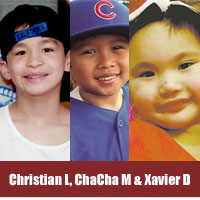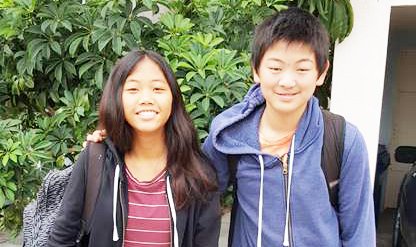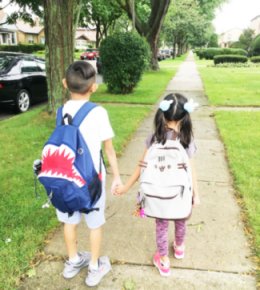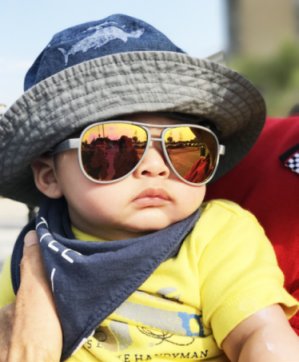
By: Christian L ChaCha M Xavier D
Red Cross and Sport Clips Haircuts partner to raise awareness of childhood cancers, offer free haircut coupon to donors in September
ILLINOIS (Aug. 28, 2018) – During Childhood Cancer Awareness Month this September, the American Red Cross encourages eligible donors to give blood to support kids, teens and young adults battling cancer, as well as others in need of transfusions.
According to the National Cancer Institute, more than 15,000 children and adolescents in the U.S. are diagnosed with cancer each year. Childhood cancer patients may need blood products on a regular basis during chemotherapy, surgery or treatment for complications.
Wren Jansen was diagnosed with acute lymphoblastic leukemia, the most common form of childhood cancer, at age 3. In the two years since her diagnosis, Wren has received 16 blood and platelet transfusions, which she calls “unicorn juice,” thanks to a crafty nurse who used the term to calm her fears during treatment. These “magic” gifts from generous donors have helped restore Wren’s strength and spirit so she can be a normal 5-year-old and fight back against cancer.
In December, Wren and her family hope to mark a special milestone – the end of treatment and the battle with cancer won.
Blood and platelet donors of all blood types, especially type O negative and O positive, are urgently needed to replenish the blood supply following a critical summer blood shortage. As a thank-you, those who come to give blood or platelets Aug. 31-Sept. 4 will receive a Red Cross aluminum water bottle, while supplies last. Make an appointment to donate by downloading the free American Red Cross Blood Donor App, visiting RedCrossBlood. org or calling 1-800-RED CROSS (1-800-733-2767).
Sport Clips and Red Cross partnership highlights childhood cancer awareness
Donors can do good and look good this September when they donate blood or platelets with the Red Cross and get a free haircut coupon from Sport Clips Haircuts – a proud partner of the St. Baldrick’s Foundation, which supports research to find cures for childhood cancers.
“The Red Cross and Sport Clips share a commitment to helping kids kick cancer, and we are thrilled to partner in September for the Saving Lives Never Looked So Good campaign to help bring attention to this important topic,” said Donna M. Morrissey, director of national partnerships, Red Cross Biomedical Services. “We are grateful to Sport Clips for their continued support of the Red Cross and for thanking the generous blood and platelet donors who help make lifesaving treatments possible for many childhood cancer patients.”
Those who come out to give blood or platelets Sept. 1-30 will receive a coupon for a free haircut via email several days after their donation. The coupon is valid through Nov. 11, 2018, at participating Sport Clips locations. Donors must have a valid email address on record to receive the coupon.
“With Sport Clips, the Red Cross and St. Baldrick’s joining forces during Childhood Cancer Awareness Month, we hope to spread the word about the importance of blood donations, especially for children fighting cancer,” said Amanda Palm, communications manager for Sport Clips. “Offering a free haircut is our way of saying thank you to blood donors everywhere.”
Donors are urged to make an appointment to donate using the free American Red Cross Blood Donor App, by visiting RedCrossBlood.org/sportclips or by calling 1-800-RED CROSS (1-800-733-2767). The Red Cross and Sport Clips encourage donors to use the hashtag #SavingLivesLooksGood to share their new looks and invite others to give.
Red Cross Offers Back to School Safety Steps As Nation’s Classrooms Get Ready for New School Year
Keeping all students safe is the primary concern for everyone, but there are special steps for parents of younger kids and those going to school for the first time:
· Make sure the child knows their phone number, address, how to get in touch with their parents at work, how to get in touch with another trusted adult and how to dial 9-1-1.
· Teach children not to talk to strangers or accept rides from someone they don’t know. SCHOOL BUS SAFETY · If children ride a bus to school, they should plan to get to their bus stop early and stand away from the curb while waiting for the bus to arrive.
· Board the bus only after it has come to a complete stop and the driver or attendant has instructed you to get on. · Only board your bus, never an alternate one.
· Always stay in clear view of the bus driver and never walk behind the bus. · Cross the street at the corner, obeying traffic signals and staying in the crosswalk.
· Never dart out into the street or cross between parked cars. GETTING TO SCHOOL BY CAR, BIKE, ON FOOT · If children ride in a car to get to school, they should always wear a seat belt. Younger children should use car seats or booster seats until the lap-shoulder belt fits properly (typically for children ages 8-12 and over 4’9”), and ride in the back seat until they are at least 13 years old.
· If a teenager is going to drive to school, parents should mandate that they use seat belts. Drivers should not use their cell phone to text or make calls, and should avoid eating or drinking while driving.
· Some students ride their bike to school. They should always wear a helmet and ride on the right in the same direction as the traffic is going. · When children are walking to school, they should only cross the street at an intersection, and use a route along which the school has placed crossing guards. Parents should walk young children to school, along with children taking new routes or attending new schools, at least for the first week to ensure they know how to get there safely. Arrange for the kids to walk to school with a friend or classmate. DRIVERS, SLOW DOWN! Drivers should be aware that children are out walking or biking to school and slow down, especially in residential areas and school zones. Motorists should know what the yellow and red bus signals mean. Yellow flashing lights indicate the bus is getting ready to stop and motorists should slow down and be prepared to stop. Red flashing lights and an extended stop sign indicate the bus is stopped and children are getting on or off. Drivers in both directions must stop their vehicles and wait until the lights go off, the stop sign is back in place and the bus is moving before they can start driving again.
PREPARE FOR EMERGENCIES AND TAKE A FIRST AID CLASS
Know what the emergency plan is at your child’s school in case a disaster or an unforeseen event occurs. Develop a family emergency plan so everyone will know who to contact and where to go if something happens while children are at school and parents are at work. Details are available at redcross.org/prepare. The Red Cross First Aid App provides instant access to information on handling the most common first aid emergencies whether it be before, during or after school. Download the app for free by searching for ‘American Red Cross’ in your app store or at redcross.org/apps. Learn and practice First Aid and CPR/AED skills by taking a course (redcross.org/takeaclass) so you can help save a life.

Emilia and James Wee Sit, grandchildren of Jo Abaya – Wee Sit are pictured ready for “FIRST DAY OF SCHOOL” in Hermosa Valley Middle School, California where they are enrolled in 8th and 7th grades respectively. While Emilia is involved in beach volleyball, James plays both hockey and football and also does PARKOUR (a form of gymnastics). Their parents are Evro & Marilyn Wee Sit.

Back to school…. Siblings Kristian Dayrit, 9, (2nd grade) and Jordan Dayrit, 7, 4th grade), students at East Prairie School in Skokie

Landon Levi Bayan Frias First Baby of Rainel & Vanessa Frias; first grandbaby of Nell and Lain Frias.
 VIA Times – September 2018 Issue Vital News, Vibrant VIews for Asian Americans in Chicago & Midwest
VIA Times – September 2018 Issue Vital News, Vibrant VIews for Asian Americans in Chicago & Midwest

